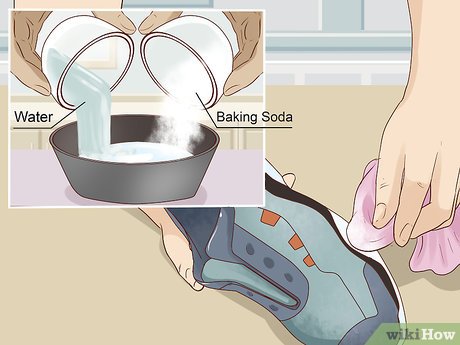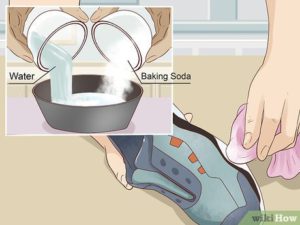How to clean icy soles with baking soda recipe

How to clean icy soles with baking soda
Equipment
- Baking soda - Soft-bristle brush or toothbrush - Water - Bowl or container - Cloth or towel
Instructions
- Gather the necessary materials: - Baking soda - Soft-bristle brush or toothbrush - Water - Bowl or container - Cloth or towel2. Prepare the cleaning solution: - In a bowl or container, mix baking soda with a small amount of water to form a paste. Start with about 2 tablespoons of baking soda and gradually add water until you achieve a thick but spreadable consistency.3. Apply the baking soda paste: - Take a small amount of the baking soda paste and apply it directly to the icy soles of your shoes. Use your fingers or a brush to spread the paste evenly over the soles.4. Scrub the soles: - Gently scrub the soles of your shoes using a soft-bristle brush or toothbrush. Pay extra attention to the areas with ice or stubborn stains. Continue scrubbing until the baking soda paste has covered the entire sole surface.5. Let it sit: - Once you've scrubbed the soles thoroughly, leave the baking soda paste on the shoes for about 15-20 minutes. This will allow the baking soda to work on breaking down dirt and grime.6. Rinse off the paste: - After the waiting period, rinse off the baking soda paste from the soles using warm water. Make sure to remove all traces of the paste.7. Dry the shoes: - Pat dry the soles with a cloth or towel to remove excess moisture. Leave the shoes in a well-ventilated area to air dry completely before wearing them again.It's important to note that this method may not be suitable for all shoe materials, so it's always a good idea to test the cleaning solution on a small, inconspicuous area of the soles before applying it to the entire surface. Additionally, for more delicate or expensive shoes, it might be advisable to consult the manufacturer's cleaning recommendations or take them to a professional cleaner.
Video
Notes
If you're specifically dealing with icy soles on your shoes, here are a few additional notes to keep in mind:
1. Act quickly: It's best to address icy soles as soon as possible to prevent any accidents or further damage to your shoes. The longer you wait, the more challenging it can be to remove the ice and restore the soles' grip.
2. Avoid using hot water: While warm water can help in some cleaning scenarios, using hot water to remove ice from your soles is not recommended. Rapid temperature changes can potentially damage the materials of your shoes, so stick to using lukewarm or room temperature water.
3. Use gentle techniques: When cleaning icy soles, avoid harsh scrubbing or abrasive materials that could potentially damage the shoe's surface. Opt for soft-bristle brushes or toothbrushes to gently remove the ice and dirt.
4. Consider prevention: To minimize the chances of getting icy soles in the future, consider using traction aids such as shoe grips, ice cleats, or anti-slip pads. These accessories can provide additional traction and reduce the buildup of ice on your shoe soles.
5. Check shoe compatibility: Different shoe materials may require specific cleaning methods. Before attempting any cleaning techniques, verify the manufacturer's instructions or recommendations for your specific shoe type. Some materials, such as suede or delicate fabrics, may require specialized cleaning products or professional cleaning.
Remember, maintaining the grip and cleanliness of your shoe soles is crucial for your safety and comfort. By promptly addressing icy soles and using appropriate cleaning methods, you can help ensure optimal performance and extend the life of your shoes.
Tried this recipe?Let us know how it was!






